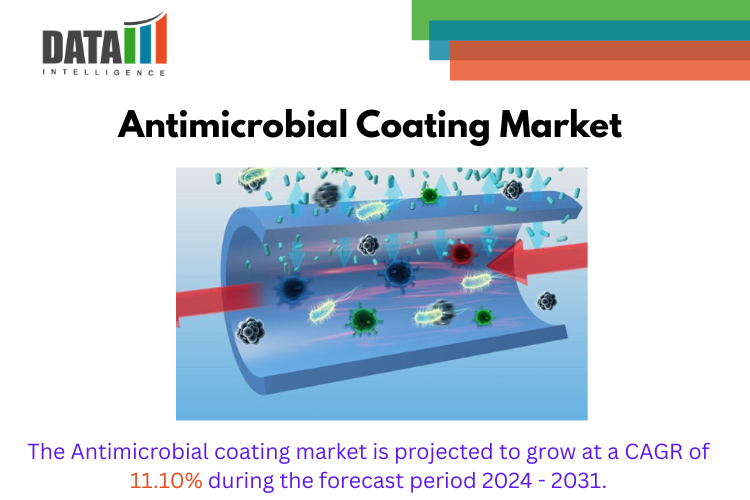Antimicrobial Coating Market Evolves with Nano‑Silver,Copper & Photocatalytic Technologies for Hygiene|DataMIntelligence
Antimicrobial Coating Market grows with rising healthcare demand, food safety norms, and innovations in nano-silver, copper, and TiO₂ technologies.
Antimicrobial coatings are no longer optional they’re essential. By embedding biocidal agents into surfaces, we’re creating safer, self‑disinfecting environments that fight pathogens continuously.”
NEW YORK, NJ, UNITED STATES, June 28, 2025 /EINPresswire.com/ -- Market Overview :— DataM Intelligence
Antimicrobial Coatings are specialized surface treatments that prevent the growth of bacteria, fungi, algae, and viruses on various materials ranging from door handles and handrails to medical devices and food-processing equipment.
By embedding active biocidal agents such as silver ions, copper compounds, or quaternary ammonium salts into paints, varnishes, or polymer films, these coatings provide continuous disinfection without the need for frequent chemical cleaning. Rising awareness of healthcare-associated infections (HAIs), stricter regulatory requirements, and a growing emphasis on hygiene in public and commercial spaces have driven strong demand for antimicrobial surface solutions. The global antimicrobial coating market is set to grow at a CAGR of 11.10% from 2024 to 2031, with forecasts indicating robust uptake across both mature and emerging economies.
Get Latest Sample Report Pdf : https://datamintelligence.com/download-sample/antimicrobial-coating-market
Market Drivers are :
Healthcare-associated infection prevention: Hospitals and clinics adopt antimicrobial surfaces to reduce HAIs, improve patient outcomes, and lower operational costs.
Stringent hygiene regulations: Government and industry guidelines, especially in food processing and hospitality, mandate the use of antimicrobial materials for food-contact surfaces.
Increased public health awareness: The COVID‑19 pandemic underscored the importance of continuous disinfection, driving demand in transportation, retail, and educational facilities.
Growing demand in electronics and touchscreens is driving the need for antimicrobial coatings on shared devices like ATMs, kiosks, and smartphones to reduce microbial transmission and enhance user safety.
Growth in building & construction: Commercial buildings and residential complexes integrate antimicrobial paints and surface finishes for safer indoor environments.
Marine and water treatment applications: Coatings on ship hulls, water storage tanks, and pipelines mitigate biofouling and microbial corrosion, extending service life.
Innovation in nanotechnology: Nano‑silver, titanium dioxide, and zinc oxide enable long-lasting, transparent coatings without compromising aesthetics or functionality.
Market Key Players are :
Major companies driving innovation, production, and market expansion include:
PPG Industries
Nippon Paint Holdings
AkzoNobel
The Sherwin‑Williams Company
Axalta Coating Systems
DuPont de Nemours
RPM International Inc.
Diamond Vogel Paint Company
BASF SE
Burke Industrial Coatings LLC
These players leverage extensive R&D to develop proprietary formulations, strategic partnerships to access end‑user segments, and global distribution networks to accelerate market penetration.
Market Segmentation :
By Technology
Silver‑based coatings: Leverage ionic silver’s broad antimicrobial spectrum.
Copper‑based coatings: Utilize copper ions’ antiviral and antibacterial properties.
Titanium dioxide (TiO₂): Photocatalytic action under UV light generates reactive oxygen species.
Zinc oxide (ZnO) & other metal oxides: Provide antimicrobial action with lower toxicity.
Quaternary ammonium compounds (QAC): Cationic surfactants embedded in polymer matrices.
By Substrate
Metal (stainless steel, aluminum)
Plastic (polycarbonate, PVC, ABS)
Glass and ceramics
Textiles and nonwovens
Concrete and wood
By End‑Use Industry
Healthcare (hospitals, clinics, laboratories)
Food & Beverage (processing plants, packaging)
Transportation (airports, railways, buses)
Building & Construction (interiors, HVAC systems)
Electronics & IT (touchscreens, data centers)
Marine & Water Treatment
This segmentation highlights the versatility of antimicrobial coatings from high‑risk medical environments to everyday consumer electronics.
Latest News – USA
In early 2024, PPG Industries announced the launch of a next‑generation antimicrobial paint, leveraging nano‑silver technology to inhibit 99.9% of surface-borne microbes for up to five years[1]. Meanwhile, DuPont de Nemours secured FDA clearance for its novel copper‑embedded laminate panels, now approved for use in hospital operating rooms and food‑processing facilities across the United States[2].
Latest News – Japan
During Q2 2024, Nippon Paint Holdings introduced a photocatalytic TiO₂ coating optimized for Japan’s humid climate, reducing mold growth on building exteriors by over 80%[3]. AkzoNobel also partnered with a major Japanese rail operator to retrofit passenger trains with durable antimicrobial interior coatings, aimed at improving hygiene in high‑traffic urban transit systems[4].
Recent Key Developments are :
AkzoNobel has broadened its SanShiel antimicrobial powder coatings range, adding over 20 new colors and textures to better serve the architectural façade and furniture sectors.
Sherwin-Williams has finalized the acquisition of a Canadian biocide manufacturer, incorporating its proprietary QAC technology into the company’s Protective & Marine Coatings division.
Axalta Coating Systems launched a UV‑curable antimicrobial clearcoat for automotive interiors, enhancing long‑term passenger safety without altering aesthetics.
RPM International Inc. rolled out an antimicrobial sealant for water treatment facilities, achieving EPA registration for control of Legionella and biofilm formation.
BASF SE announced a joint venture with a leading textile fiber producer to embed zinc oxide nanoparticles into nonwoven hospital gowns, ensuring continuous antimicrobial protection.
These milestones reflect a shift toward multifunctional coatings that combine durability, eco‑friendly profiles, and regulatory compliance.
Conclusion :
The antimicrobial coating market is evolving from niche medical applications into a broad-based solution for public‑health protection and asset longevity. Fueled by rising hygiene standards, regulatory mandates, and technological advances in nanomaterials, the market’s 11.10% CAGR through 2031 underscores sustained opportunity across industries. Looking ahead, developments in smart coatings capable of sensing contamination and self‑regenerating biocidal activity will further elevate the role of antimicrobial surfaces in safeguarding human health and critical infrastructure. As end users increasingly prioritize integrated hygiene solutions, antimicrobial coatings will remain a vital component of the clean‑tech toolkit.
Purchase Your Subscription to Power Your Strategy with Precision: https://www.datamintelligence.com/reports-subscription
Browse related reports :
Graphene Coating Market
Graphene Heating Ink Market
Sai Kumar
DataM Intelligence 4market Research LLP
+1 877-441-4866
email us here
Visit us on social media:
LinkedIn
X
Legal Disclaimer:
EIN Presswire provides this news content "as is" without warranty of any kind. We do not accept any responsibility or liability for the accuracy, content, images, videos, licenses, completeness, legality, or reliability of the information contained in this article. If you have any complaints or copyright issues related to this article, kindly contact the author above.

